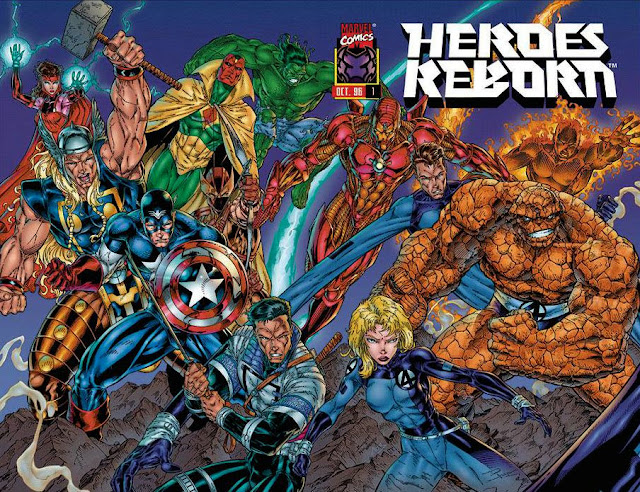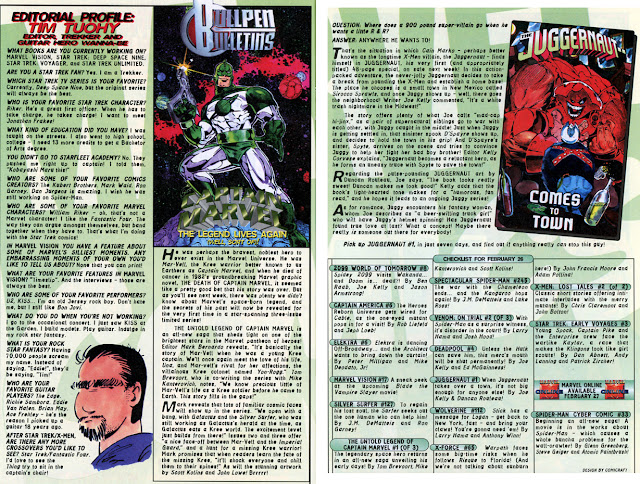In
Part 1 of our look at Marvel's line of books published prior to the close of the 20th century--specifically, April of 1997, twenty-five years ago this month--we covered a number of titles which still had running series at the time, with the exception of four mainstream books that came to the end of their run following the onslaught of... well, Onslaught, the malevolent psychic entity composed of the consciousness of both Charles Xavier and the master of magnetism, Magneto. Those four titles--
Invincible Iron Man,
Fantastic Four,
The Avengers, and
Captain America--all ceased publication in August-September of 1996 and were relaunched in November for a limited, year-long stint that fell under a single promotional banner
*:
*Unrelated to the 2021 series of the same name (though the concepts share similarities).
"Reborn" as in all of the characters suddenly leading different lives and having different histories and memories than those individuals who preceded them. For the duration, readers would be kept in the dark on the underlying questions: How, and why?
April finds each of these titles in its sixth issue, where, alternate world or not, all have discovered the time-tested and lucrative advantage of a crossover story--namely, "Industrial Revolution" (don't forget to invert the letter "n"), where the reactor core of the now-in-ruins Avengers Island is in danger of a meltdown which would irradiate most of the United States. Aside from the obvious historical context, it might seem at first perplexing as to where the "revolution" part comes into play; but while the crisis acts to draw the heroes of all titles together, the story also flashes back to the formation of a group of "eggheads" (as Ben Grimm would refer to them--Bruce Banner, Victor Von Doom, Connor "Rebel" O'Reilly, Anthony Stark, and Reed Richards) who would work to "protect the world from its own basest instincts" and "wield power for the benefit of all mankind," baseline goals which Henry Pym jokingly refers to as the group's "industrial revolution." (Pym seems to be omitted from this group--maybe that's a good idea, though it feels like a better fit overall with just the five of them.)
At the time, the rundown of partly outsourced talent for each book is listed as follows:
Fantastic Four
Script: Brandon Choi
Art and Plot: Jim Lee
Invincible Iron Man
Script: Scott Lobdell
Art: Jim Lee, Whilce Portacio, Ryan Benjamin
The Avengers
Plot: Rob Liefeld and Jeph Loeb
Script: Jeph Loeb
Art: Ian Churchill
Captain America
Script: Jeph Loeb
Art and Plot: Rob Liefeld
In a relatively small dose of thirteen issues each, the "Heroes Reborn" collection of books makes for an interesting diversion, though eventually the characters' main titles would undergo an informal, er, "Heroes Rebooted" refit in preparation for their new 1998 runs (which would reset each of them to issue #1). For roughly the first half of the '96-'97 books, you'll find the writing crisp and engaging while retaining the "flavor" of the characters, along with an influx of other mainstream characters that were not spirited away during the Onslaught crisis and are still handling matters in their regular series. (E.g., Cable figures prominently in the "reborn" Captain America book.)
In order, then, here are a few sample pages from each title's sixth issue detailing key scenes from the Industrial Revolution crossover--starting with its prologue in Fantastic Four, where we pick things up during a crisis already in progress involving the FF, the Silver Surfer, the Black Panther, Doom, Wyatt Wingfoot... and the Super Skrull, whom Lee appears to have turned into a dead ringer for the Abomination.
























